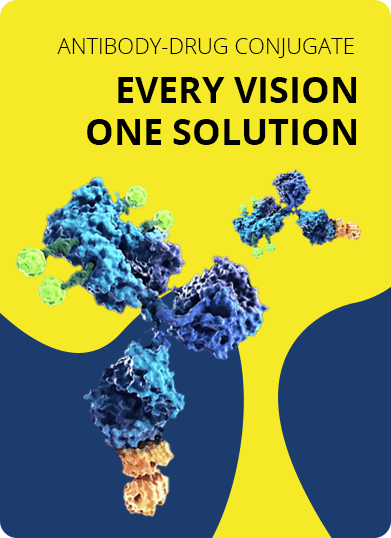- Home
- ADC Development
- ADC In Vivo Analysis
- ADC Pharmacokinetics Characterization
- Case Study 1: Pharmacokinetics Analysis of HER2-targeting ADCs
Case Study 1: Pharmacokinetics Analysis of HER2-targeting ADCs
Creative Biolabs fully understands the complexity of antibody-drug conjugates (ADCs) researches and we are committed to provide our clients with top-quality services and products for ADC development. To support pre-clinical ADCs studies, we offer a comprehensive set of in vivo evaluation services as part of our ADCs development programs. Here, the in vivo evaluations of an anti-HER2 ADC is taken as an example to demonstrate our in vivo ADC PK and efficacy services.
Overview of HER2
Human epidermal growth factor receptor 2 (HER2) is a member of the epidermal growth factor receptor superfamily along with three other isoforms. They are transmembrane proteins encoded by the ERBB2 gene. Hetero-dimerization of HER2 with other HER isoforms, usually HER1 or HER3, triggers auto-phosphorylation of tyrosine residues in the cytoplasmic domain of the receptor and subsequently leads to cell proliferation. Current researches consider HER2 as an important therapeutic target for carcinoma treatment. HER2 positive breast cancer is the most extensively studied HER2-specific model, while other HER2 expressing tumors have been identified in endometrium, colon, bladder, lung, uterine cervix, head and neck, and esophagus.
Anti-HER2 ADC therapy
A number of biologics such as Trastuzumab, Lapatinib, Petuzumab, and Neratinib, have been successfully developed to target HER2 in breast, gastric, and gastroesophageal cancers. Ado-trastuzumab emtansine (T-DM1, Kadcyla) is a FDA approved ADC drug consisting of a monoclonal antibody (Trastuzumab) conjugated with a cytotoxin, emtansine, via a non-cleavable MCC linker. T-DM1 exhibits a 3-fold impact on tumor cells: (1) Trastuzumab inhibits cancer cell growth by binding to HER2/neu receptor; (2) Trastuzumab recruit effector activities for tumor cell elimination; and (3) DM1 causes cell damage by disrupting microtubule dynamics.
 ADCs targeting caner surface target HER2. Anti-HER2 monoclolnal antibodies interact with the antigen on its Nt extracellular domain and deliver the payload drug into the tumor cells via receptor mediated endocytosis.
ADCs targeting caner surface target HER2. Anti-HER2 monoclolnal antibodies interact with the antigen on its Nt extracellular domain and deliver the payload drug into the tumor cells via receptor mediated endocytosis.
In vivo Efficacy Evaluation of Anti-HER2 ADCs
The anti-HER2 ADC in vivo efficacy evaluation is divided into two stages:
(1) Efficacy evaluation by xenograft animal models
Creative Biolabs is in possession of various xenograft tumor models for HER2-specific ADC evaluation. All animal experiments are supervised under direction of Institutional Animal Care and Use Committees (IACUCs). Immuno-compromised mice receive subcutaneously injection of HER2 expressing human breast cancer cells (e.g. NCL-N87, SCH or 4-1ST) or human gastric cancer cells (e.g. MKN-28 or NCL-N87) in the right or left flank to generate the xenograft models for corresponding cancers. When tumor expansion meet proper criterion, the mice are given certain dose of ADC product via tail vein injection. Tumor size are measured by calipers and volume are calculated by using reported formula. During xenograft animal experiments, routine clinical observation and postmortem analysis are performed by specialized technicians. Physiological parameters such as weight loss, food consumption, and physiological signs… are recorded and reported as formal documentations.
(2) In vivo pharmacokinetics (PK) analysis
The purpose of the PK studies is to gather information regarding the adsorption, distribution, metabolism, and excretion routes of the ADC for clinical assessment preparations. Creative Biolabs utilizes high-quality laboratory animals including rodents and non-rodents for the PK experiments. Standard protocols for PK evaluations are reviewed and approved by IACUC before project commencement.
-
Dose administration and sample collection
Laboratory animals maintained by Creative Biolabs are kept separately in wire cages under a pathogen-free condition. The animal facility obeys a 12h light/12h dark cycle, and the animals are fed with certified diets. ADCs are given to animals via intravenous, oral, or subcutaneous routes. Clinical observations and animal physiological parameters such as body weight, food consumption is recorded while blood samples (and/or tissue samples if necessary) are collected during each experiment.
-
Bioanalysis
The plasma concentration of an anti-HER2 ADC components (total antibody, conjugated antibody) are measured by ELISA assays. Total antibody is captured using a recombinant HER2 extracellular domain protein fraction and detected by anti-human Fc-HRP. Conjugated antibody is measured by anti-drug antibody and biotinylated mesothelin extracellular domain. In vivo drug to antibody ratio (DAR) is quantified by affinity capture LC-MS. In this analysis, streptavidin-coated paramagnetic beads are conjugated with biotinylated HER2 extracellular domain or anti-drug antibody for ADC capture. Immobilized ADCs are washed, eluted and analyzed by a LC-MS system. The percentages of each DAR moieties in an ADC sample are obtained from LC-MS signal intensity. The concentration of individual DAR species (such as DAR1, DAR2 etc.) is calculated by multiplying the percentage of relative DAR with the total antibody results from ELISA analysis.
-
Pharmacokinetics analysis
Different PK models are employed in a case-specific manner to determine the in vivo pharmacokinetics of an ADC. Taken into consideration of the complicated nature of an ADC (multiple analytes resulting in multiple elimination pathways), Creative Biolabs develops appropriate PK models based on pre-clinical data. For instance, for certain ADCs, we rely on the non-compartmental model to analyze the collected PK data and calculate parameters like Cmax, AUC, Tmax, T1/2, Vd, CL.
For Research Use Only. NOT FOR CLINICAL USE.

Online Inquiry
Welcome! For price inquiries, please feel free to contact us through the form on the left side. We will get back to you as soon as possible.
